by Winding Pathways | Apr 22, 2017 | Birds, Flowers/Grasses, Nature, Trees/Shrubs, Wonderment
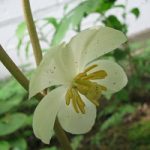
Beautiful blossoms hide under the umbrella-like leaves.
First submission in! Hey all, on Facebook Winding Pathways invited folks to submit a favorite spring photo – tree, scene, flower, animal – with a short write-up of why you like that picture. And, Kansas readers Emily and Zach Hemmerling have already replied! Way to Go!
Now, I’d love to have about a dozen more so send them in to our email and I’ll continue processing and then post. These samples of spring pictures. Join in the fun and share your descriptions!
-

-
Photo – Protective custody
-
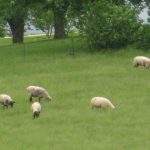
-
Photo of sheep in pasture
-
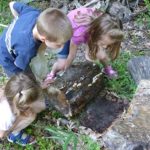
-
Kids develop strength, cooperation, and curiosity as they explore outside.
-
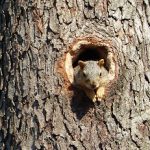
-
It’s a long way down, Mom.
-
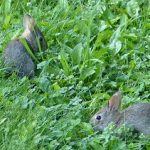
-
Bunnies are on their own as soon as the mother weens them.
-
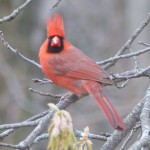
-
Photo – On a wild and windy day this Cardinal sang out his love song.
-
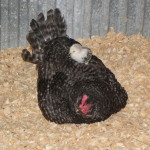
-
This mama hen with chick on her back fluffs up clean wood chips.
-
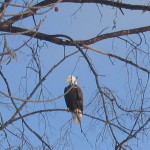
-
Eagle watching over nest.
-
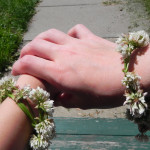
-
Clover bracelets
by Winding Pathways | Mar 7, 2017 | (Sub)Urban Homesteading, Flowers/Grasses, Foraging, Nature, Weeds
As soon as a few warm days arrive early each spring we search our yard at Winding Pathways for two of our favorite plants – Stinging Nettles and Dandelions.
To most people they’re weeds. To us they’re delicious yard gifts.
STINGING NETTLES
Stinging nettles are one of the tastiest of all wild greens. They begin growing very early each spring and are usually ready to pick about the time when gardeners plant spinach and lettuce. In Iowa that’s sometime in April. Nettles love moist soil at the edge of woods where they receive partial shade. Often they’re common on yard edges. Nettles are well named, because they can sting! Another name for the plant is “three minute itch”, because the slight stinging sensation is just temporary. There’s a way to avoid the “itch.”
We pick nettles when they are only a couple of inches tall. To avoid the sting, we either wear light gloves or carefully pluck off the top few leaves between the thumb and forefinger. About 100 leaves are plenty for dinner for the two of us. We bring the plucked nettles into the kitchen, rinse them well, and boil them for just a few minute. It’s really more like steaming them as we only put about a half inch of water in the pan. Once steamed the sting disappears. Put a dollop of butter on them with a sprinkle of vinegar and enjoy as the year’s first green crop.
We continually pick from the same nettle patch and each plant constantly creates new leaves at the growing tip. This extends the picking season for over a month, and by then our spinach is ready to harvest from the garden. For the rest of the growing season, foraging insects enjoy the nectar of the nettles.
DANDELIONS
Almost everyone knows that dandelions are edible but most people who try them quickly toss the bitter plants out and never try again. Take heart and try again! Dandelions are revered in many eastern cities where Italians live. Festivals abound across the country “…from the Redwood forests to the Gulf Stream waters….” (apologies to Woody Guthrie) and the Amana Colonies in Iowa are known for their dandelion wines. Google Dandelion Festivals to find one near you. One coming up for St. Patrick’s Day is Dandelion Days in California.
Dandelions are delicious but there’s a trick to enjoying them. The best ones are picked in very early spring when the leaves are brand new. Those poking out from under leaves are semi blanched, lack bitterness, and are delicious and packed with vitamins. As soon as dandelion leaves are full size they are too bitter to eat without special processing. Young blanched leaves can be eaten raw in salad or steamed.
A CAUTION
Before eating any wild plant for the first time make sure you correctly identify it, using at least two sources for identification……….an expert forager and a wild food book, or a wild food book and a credible website, for example. Our all-time favorite source for wild food information is Euell Gibbons’ classic book STALKING THE WILD ASPARAGUS. If you spot one at a used book sale snap it up as quickly as you do fresh nettles. Some helpful websites include Eat the Weeds , Eat the Weeds You Tube Videos, and Food52. Episode 134 of Eat the Weeds features neighborhood foraging. At about six minutes, Green Deane, the host, shows and talks about dandelions.
by Winding Pathways | Sep 5, 2016 | Flowers/Grasses, Nature, Reflections/Profiles, Wonderment
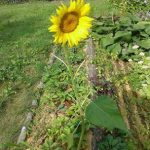
A sweet tribute to summer.
A short note from Jan Watkins about her summer companion.
“This lone sunflower volunteered to be in my garden. It looks in at me and makes me smile each day. It’s the little things. The special thing about this flower besides choosing my garden in which to bloom, is that it’s not even looking at the sun. It looks in at me!! Now that’s sweet!”
Thanks, Jan, for sharing on Winding Pathways!
by Winding Pathways | Aug 20, 2016 | Bugs, Flowers/Grasses, Nature
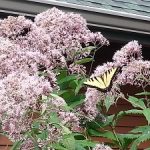
Joe-Pye Weed can grow to great heights and is a favorite of butterflies and other pollinators.
Carol Lampe shared these pictures and write up of her wondrous yard and the pollinator action on Joe-Pye Weed (Eupatorium purpureum). This is a particularly valuable fast food stop for migrating butterflies as it lasts into autumn. We have found it a bit difficult to start and then it takes off! Give it plenty of space and enjoy the butterflies.
“Here is a butterfly twofer from my flower bed. In the forefront you can see the female Eastern Tiger Swallowtail (Papilio glaucus) sitting on a Joe-Pye Weed. There were several Swallowtails out there that day.
“Joe-Pye Weed is an herb and the butterflies really seem to like it. Native Americans, and later, white settlers, made much use of Joe-Pye Weed. Teas of the roots or tops were used as a diuretic, as well as for rheumatism, gout, fevers, diarrhea, respiratory disorders, and even impotence. Modern science has not confirmed their efficacy.
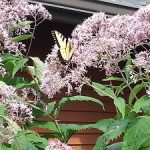
Sipping nectar on Joe-Pye Weed.
“Tucked toward the back is a Red Admiral (Vanessa atalanta). The males are territorial and many times can be found in the same location day to day.”
Thanks, Carol, for sharing your wondrous yard with Winding Pathways.
by Winding Pathways | Aug 8, 2016 | Bugs, Flowers/Grasses, Nature, Reflections/Profiles, Wonderment
Here is a story fro Gordon and Nancy Bena about their interest in Monarchs, their chrysalis find and how they began to tend their property differently to encourage insects.
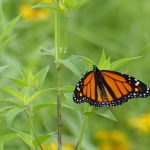
Adult butterflies need nectar to sip and plants to rest on.
“We went to the presentation given at the library that told us the fate of the Monarch. With that we were very careful not to mow down any Milkweed plant that we saw in the yard. We also planted Butterfly Weed and I did not mow any of the clover down this year.
“This particular plant where we found the chrysalis was kind of blown over from one of the wind storms and we put a tomato cage around it to hold it up so the caterpillars would have something to munch on. When I went down to get the mail the other day, I stopped to check that the plant was still standing. This is when I found the chrysalis. I went around to the other plants but I’m afraid that this is the only success story I found so far.”
Thanks, Gordon and Nancy!
by Winding Pathways | Jul 29, 2016 | (Sub)Urban Homesteading, Flowers/Grasses, Nature, Reflections/Profiles, Wonderment
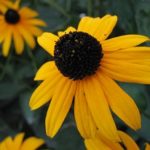
A brilliant harbinger of summer with a long lasting biannual bloom.
Many years ago word came that a dear friend had tragically died in Utah, over a thousand miles from our Iowa home. With deep feelings of grief of the loss of a vibrant young woman I (Rich) felt the need to “do something for her.”
We were in the process of restoring prairie to a bare patch of ground on recently purchased piece of land at the Indian Creek Nature Center. A bag of prairie wildflowers perched against my office wall caught my eye. I grabbed the bag, walked to the meadow and scattered the seeds in the woman’s honor.
The seeds thrived. Now, a dozen years later they grace the prairie with color and restore memories of my friend. We shared this story with our friend’s husband who was moved. So, we decided to share our way of honoring and memorializing ones dear to us.
Planting flowers, shrubs, and trees in a yard or park is an outstanding way to reduce grief, maintain memories, honor someone, and make our world healthier and more vibrant.
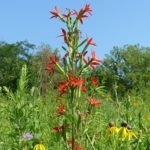
What a stunner!
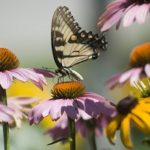
Sipping nectar
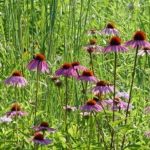
Purple Coneflowers add color to a prairie.


















